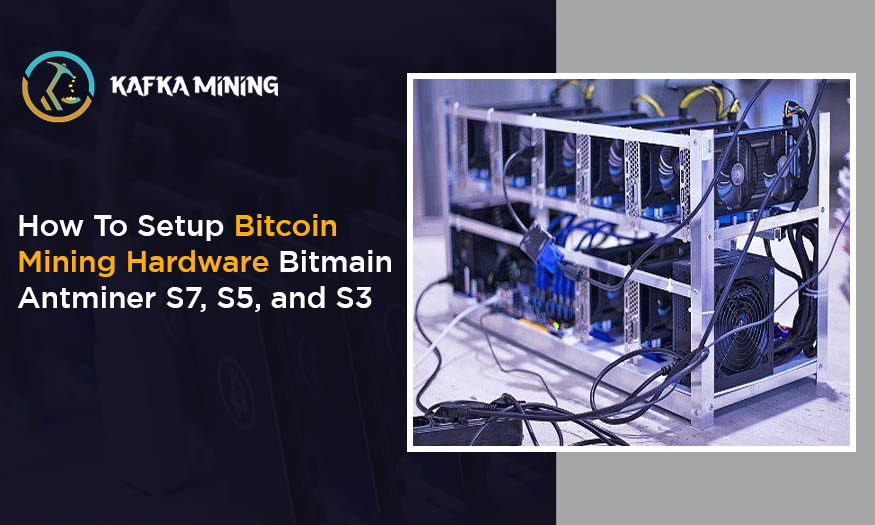
Bitcoin mining is the process by which new bitcoins are generated by solving complex mathematical problems using specialized hardware. Bitcoin mining hardware is designed to solve mathematical problems and confirm transactions on the Bitcoin network. The mining hardware is crucial to the success of Bitcoin mining, and it comes in various shapes and sizes.
In this article, we will focus on the Bitmain Antminer S7, S5, and S3, which are some of the most popular Bitcoin mining hardware. We will discuss how to set up, configure, maintain, and troubleshoot these mining devices.
Bitmain Antminer S7, S5, and S3 are ASIC (Application-Specific Integrated Circuit) mining devices that are designed to mine Bitcoin. The Antminer S7 is the most powerful of the three, with a hash rate of 4.73 TH/s, while the Antminer S5 has a hash rate of 1.16 TH/s, and the Antminer S3 has a hash rate of 450 GH/s.
The Antminer S7, S5, and S3 are all designed to be user-friendly and easy to use, with intuitive interfaces and simple setup procedures. These devices are built to be reliable and durable, with a high-quality build and excellent cooling capabilities.
Setting up the Bitmain Antminer S7, S5, and S3 is a straightforward process. The first step is to unbox the device and check that all the components are present. The components typically include the mining device, a power supply, and connecting cables.
The next step is to connect the power supply to the mining device and the wall socket. Once the device is connected to power, it will start up and begin mining. The mining device will connect to the Bitcoin network automatically and start solving mathematical problems.
Configuring the Bitmain Antminer S7, S5, and S3 is an essential step in the mining process. The configuration process involves setting up the mining pool, username, and password. The mining pool is where the device will mine, while the username and password are used to authenticate the device on the mining pool.
To configure the device, navigate to the device's web interface by entering its IP address in a web browser. Once you have accessed the web interface, enter the mining pool details, username, and password. Save the settings, and the device will start mining on the specified pool.
Maintaining the Bitmain Antminer S7, S5, and S3 is crucial to ensure the device operates at peak performance. The device's cooling system is an essential component of the mining device and must be kept clean and free of dust.
It is also essential to keep the device's firmware up to date by regularly checking for firmware updates on the manufacturer's website. The firmware updates will fix any bugs and improve the device's performance.
Like any electronic device, the Bitmain Antminer S7, S5, and S3 may experience problems. The most common problems are related to the device's cooling system, power supply, and connection to the mining pool.
If the device is not cooling correctly, check the fans and the heat sinks for dust and debris. If the issue persists, check the power supply and the connection to the mining pool. If none of these steps resolves the problem, contact the manufacturer for support.
The Bitmain Antminer S7, S5, and S3 have different hash rates, with the S7 being the most powerful. The S7 also has a higher power consumption, while the S5 and S3 have lower power consumption.
The S7 is also more expensive than the S5 and S3, but it is more powerful and efficient. The S5 and S3 are more affordable and suitable for beginners or hobbyists.
To get the most out of your Bitmain Antminer S7, S5, and S3, it is essential to follow some best practices. These include keeping the device's cooling system clean, updating the firmware regularly, and monitoring the device for any issues.
It is also essential to use a reliable and secure mining pool and to keep the device's username and password secure. Following these best practices will ensure that your Bitmain Antminer S7, S5, and S3 operate at peak performance and remain secure.
In conclusion, the Bitmain Antminer S7, S5, and S3 are excellent Bitcoin mining hardware devices that are user-friendly, reliable, and efficient. Setting up, configuring, maintaining, and troubleshooting these devices is a straightforward process that requires minimal technical knowledge.
By following the best practices outlined in this article, you can ensure that your Bitmain Antminer S7, S5, and S3 operate at peak performance and remain secure. If you have any questions or issues, consult the manufacturer's website or contact their support team.
Leave a Comment